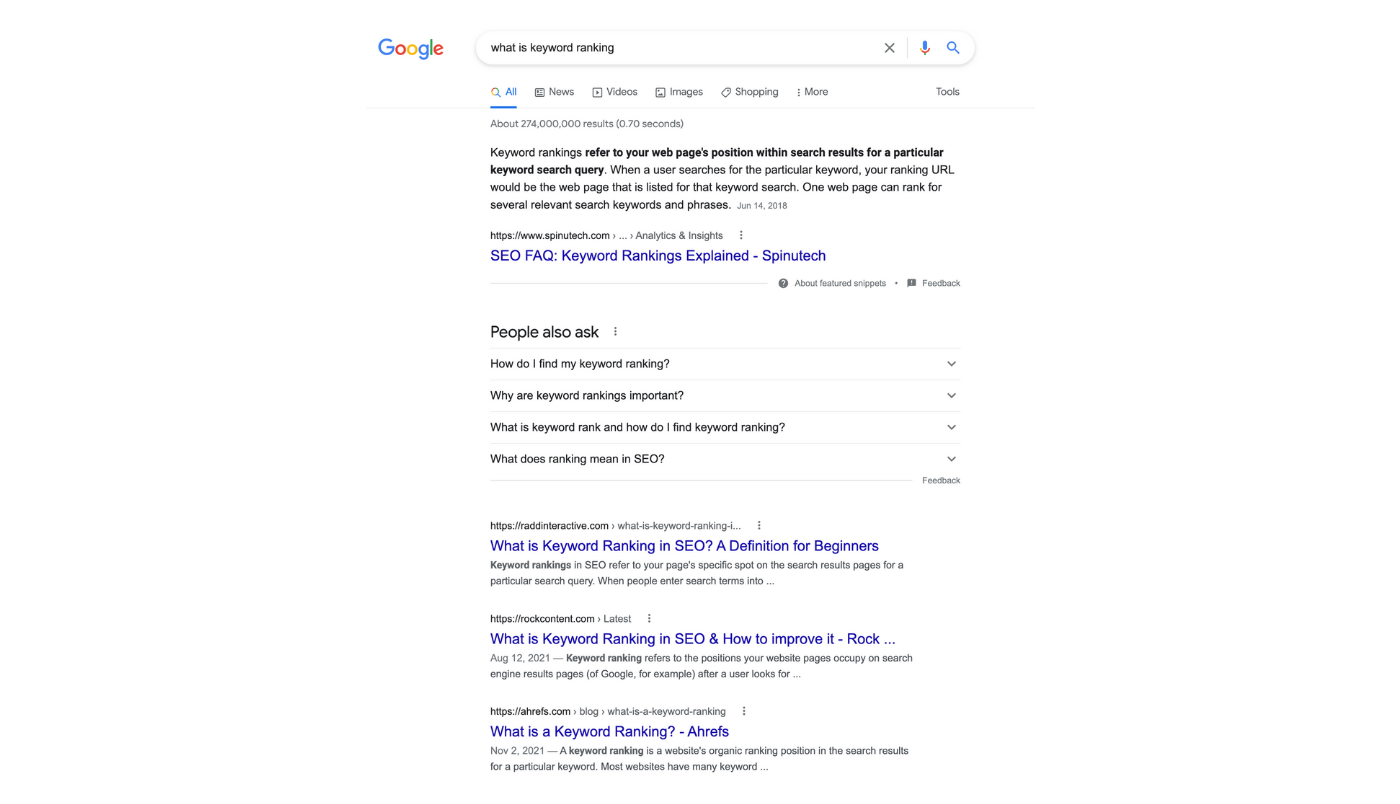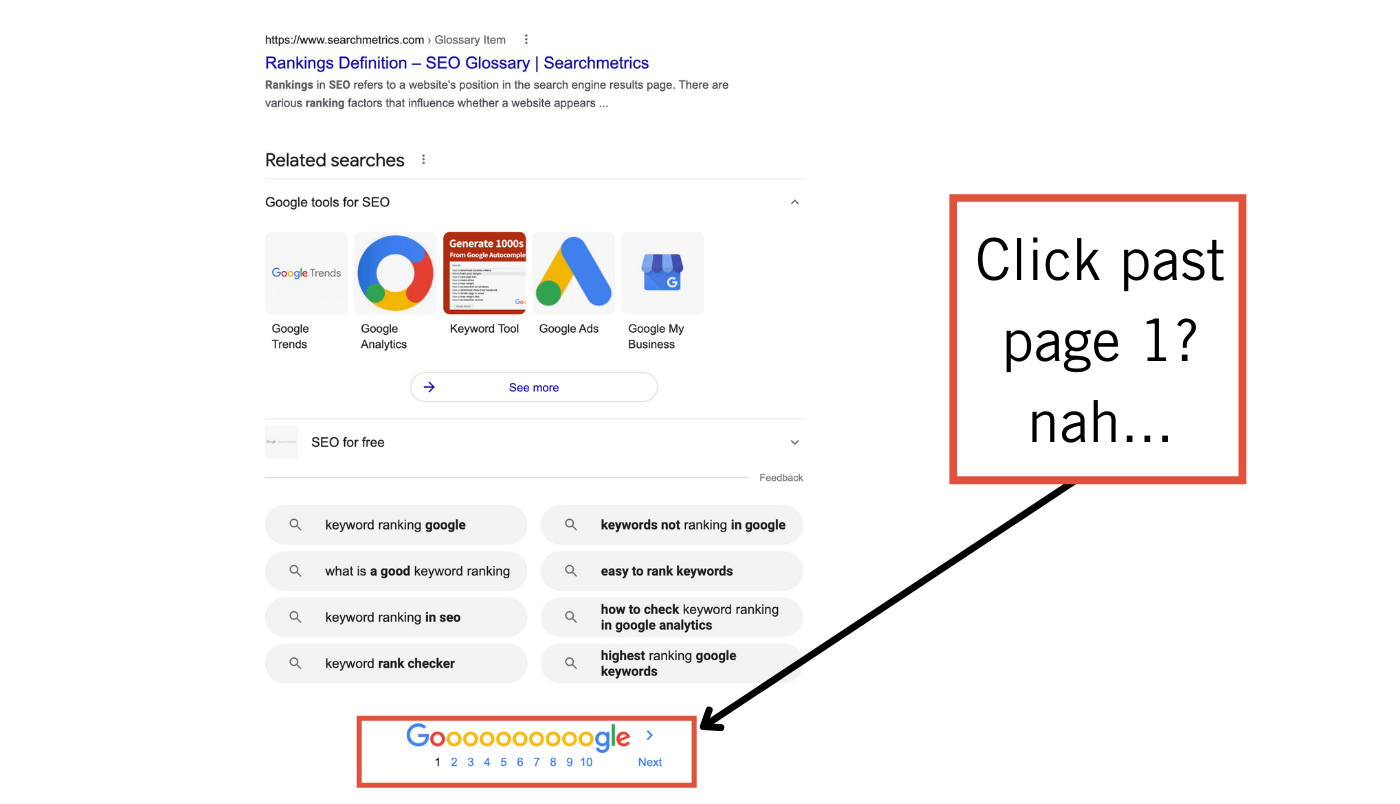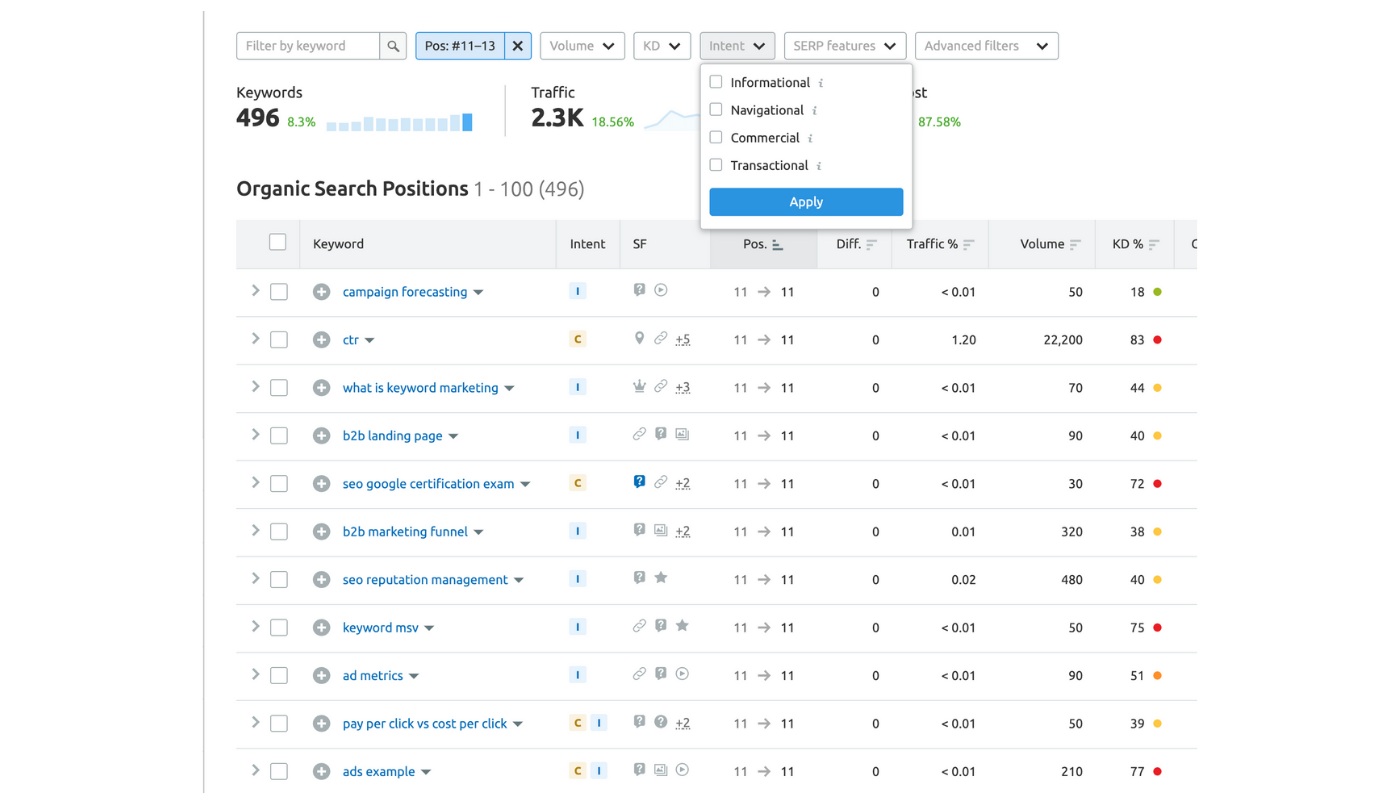Keyword ranking is a measure of how well a target keyword or set of keywords that a given website or webpage uses ranks for in the SERPs (search engine results pages).
When someone does a search online via a search engine like Google, they are searching for something specific such as a question of some sort. The results that populate after the search has been initiated are referred to as the “search engine results pages.”
The results that appear on the first page of results are prime real estate for the individual website to appear on through a keyword search. There are only ten organic search results per page, and the higher the position on the page, the more valuable the placement due to the organic traffic value it brings.

Why are Keyword Rankings Important and Why Should We Pay Attention to Them?
Keyword rankings are important because they allow a website owner or manager to know what their website actually ranks for vs what they would like to rank for.
More importantly, paying attention to the rankings data will show what the website doesn’t rank on page one for and what is close to page one, but stuck at the top of page two.
Gaining this insight allows a site owner to see opportunities to improve a page’s rankings, which will result in more traffic to their website, and therefore generate more leads or sales.
There is an inside joke in SEO:
Do you know where you can hide a dead body that no one will find?
Page 2 of Google….

The majority of people searching on the internet, especially Google, will never go past page one of the search results.

According to Brian Dean over at Backlinko, the top spot on page one of Google’s organic SERPs has an average CTR of 31.7% and is 10x more likely to receive a click than any of the other 9 spots on page one.
The order of the results on the SERPs appears in a particular order based on search engine algorithms. For example, Google’s algorithms crawl and assess information on websites, the mentions of a particular brand, their “Name, Address, & Phone #” (NAP), and their website URLs across the web to determine which website pages should appear on page one and in which order for a particular keyword.
The more relevant, authoritative, and trustworthy the brand and content on a given page are, the more likely a page will rank on page one. Having a keyword strategy prior to building out new pages or writing blog content is extremely important.
10 Easy Steps To Bumping Your Keyword Rankings
How does one go about assessing their keyword ranking, and what do you do from there? In these 10 easy-to-follow steps, you can determine which pages may provide “quick wins” in terms of ranking and learn how to update the pages so they show up on the first, instead of second, page of search results.
Step 1: Measure Your Rankings (Non-Branded)
First, identify which URLs on your website rank on the top of page two of a search results page. Using a keyword ranking tool like Semrush helps determine the URLs to focus on. For example, for any keyword that a site ranks for at the very top of page two. These are quick wins because they just need a little push to get to page one.

For this step, it is best to filter out branded keywords. Leveraging the advanced filters on the Semrush organic research dashboard view allows you to filter out branded search terms, but you can also isolate the positions on the top of page two by selecting a custom range from 11-13 (the top 3 spots on page 2 of the SERPs).
These parameters will leave you with a list of URLs that are ranking for organic non-branded keywords, their position, the corresponding URL, and a few other metrics of the keyword such as keyword difficulty (KD), searcher intent, CPC, the % of traffic that page is getting and the average search volume per month for each keyword.
To make a decision on which page you want to focus on first, focus on these metrics:
- Position
- Traffic %
- Volume
- KD (Keyword Difficulty)
A quick win can be a case where the page is in position 11, the keyword it ranks for at this position has a high search volume, a low to moderate KD, and is already showing some signs of traffic. For the traffic %, do not be misled by a percentage that is only around 1-2%. Taking the total organic traffic the given site has, this traffic can still be valuable, especially once the page/keyword is pushed to page 1.
Step 2: Identify the Target Keyword
Once you’ve selected a page to be your quick win, you want to determine which keyword that URL ranks for on the top of page two. This will be in the corresponding keyword column.
Step 3: Minimize Internal Cannibalization
Now it is time to ensure the content on this page is focused on this keyword throughout the page to minimize cannibalization of other pages’ primary keywords.
Read over the content, look at the H1 heading, the page title tag, meta description, and overall meaning of the content to determine if the keyword the page is ranking for is the best fit and aligns with the content and on-page SEO.
After confirming the page is focused and there are no other competing pages in the Semrush data for the same keyword, move on to the next step.
If there are other pages that are ranking for the same keyword, determine which is the best fit for the keyword, or if the content is blog content, whether or not to combine the two as opposed to having them compete against each other. Either way, make sure you have one page or post for this keyword.
Step 4: Baseline & Tracking Setup
Before making changes to the website page, make sure you have set up keyword tracking for that keyword and URL. At the very least keeping screenshots of the existing ranking data on Semrush or another keyword ranking tool will provide a baseline.
Recording the existing position the URL ranks for and the date should be included in the baseline data.
Step 5: Fix Technical & On-Page SEO Issues
Next, assess and optimize the foundational on-page SEO for that URL and keyword, as well as a quick check for the loading speed of the page with this tool.
List of Key Elements to Optimize:
- Check to see if the permalink includes the keyword
- If not, consider restructuring it, but make sure to set up a redirect of the old URL structure if this is changed
- Site page loading speed
- Ensure there are no elements that are slowing the page down
- Title tag optimization
- Make sure it includes the keyword and is not over 60 characters
- Meta description
- An enticing description can help the CTR from the organic results
- Image alt text
- Include at least one relevant image that can use the keyword as its alt text
- Check the number of times the focus keyword and semantically related keywords are used in the body text as well.
- Avoiding over-optimization is important, but so is making sure you have mentioned your keywords enough help with relevance to the search.
- Main Heading Structure
- One H1 heading that includes the primary keyword
- Subsequent headings
- Properly structured headings (H2s, H3, etc)
- Break up content
- Enough relevant headings to break up the content
- Headings are optimized for the topic
Improving all of these on-page SEO items will be one of the most beneficial steps of this whole process. All of these are signals to Google as to what the page is all about and really dials in the rankings.
Step 6: Success Leaves Clues: Look at the Competition
By using the SERPs preview from your Semrush or another ranking tool, take a look at the competition.
Look at competing websites to see how you can improve your own website and ranking. Be on the look out for both gaps in their content that you can aim to fill on your site and things they have (such as images, layouts, or design features that you can incorporate into your page.
Adding more relevant content and engaging images or graphics can help rankings, as well as improve the amount of time a site visitor may stay on the given page.
Step 7: Optimize for Searcher Intent & Journey UX
In addition to searches based on keywords, brands, or particular places, about 8% of all searches are questions.
Within the Semrush organic rankings tool, you are able to see what the intent of the keyword being searched for is for the given URL. One of the “intent” identifiers is informational, meaning that the user wants to find an answer to a specific question.
For example, for TOFU keywords the searcher is looking for information about a topic. They may ask questions about the topic, such as “What is a KPI?”
Once identifying what the typical intent is for the focus keyword of the URL that is close to ranking on page 1, doing research for relevant FAQs and Google’s PAA (people also ask) questions is a great way to add more value and relevance to your content.
Developing a section dedicated to FAQs and implementing FAQ schema on the page or post will provide more information and value to bump up in the SERPs as well as possibly get a featured snippet for a given question included in the page’s FAQ.
Be sure to develop unique and accurate answers when writing out the questions, so there is no plagiarism or duplicate content issues. Lastly, you can test the URL to ensure it is eligible for the SERPs rich results snippet.
According to Search Engine Watch, it is best practice to have in-depth and useful answers that are easy to read and understand, as well as about 50 words or so in length.
Step 8: Interlinking Opportunities
When assessing your organic keyword rankings, it is easy to identify other pages that are doing well in terms of ranking on page one of Google. Work to identify other pages or posts on the website for interlinking opportunities that rank for semantically related terms or topics.
Interlinking to and from the page you are trying to optimize will help power up the page. Linking the page you are optimizing from a relevant page or pages that are ranking well themselves is is a good place to start. Internal linking allows Google search engines to crawl the site and follow links to determine which pages are deemed relevant and valuable to someone doing a search on Google.
Step 9: Sitemap & Indexing
After addressing all the on-page and technical SEO, as well as content and design elements optimizations, make sure your page is indexing and getting crawled.
Ensure your website’s sitemap includes the page URL you have optimized and that it is marked to index. Submitting the URL via GSC is always a good idea, especially when significant changes have been made.
Step 10: Share On Social Media
Take advantage of your reach on social media to gain some movement and traffic to the page by sharing the page or post. Use a relevant and attention-grabbing image or graphic as well as an engaging statement or a question that is included in the FAQ that you know people are already interested in when making the post.
Traffic from the social media posts, someone else sharing the URL, or even gaining a mention of your content on another website or social media profile will all add to Google seeing that your page is being mentioned and has valuable traffic from reputable sources.
Key Takeaways for Improving Keyword Ranking to Page One
Finding the quick wins is a great way to start improving your overall rankings. The pages that rank at the top of page 2 are a great place to start.
Having a developed process that is repeatable and easy to use allows this exercise to be applied to other opportunities. Once you know the steps, targeting quick wins quickly becomes a habit and part of your ongoing SEO work.
Ensuring the on-page SEO is spot on, there are no technical issues, and really dialing in the content and UX of the blog post or page can make all the difference.
Get going on those improvements, and we will see you on page one of Google!
-
Leona Brown
Did you enjoy this article?
Share it with someone!


